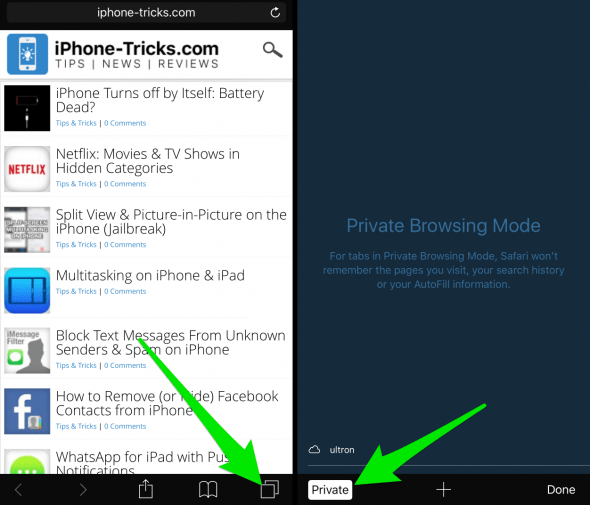

So you could, for example, keep all your work tabs in a separate Safari window that has its own cookies, extensions and favorites. Profiles on macOS and iPadOS also allow you to separate your browsing by topic or context. You can also now lock private browsing sessions behind your fingerprint, so you can step away from your computer without worrying that someone can sneak a peak while you're shopping for a gift or having to close your session. Disable private browsing on iOS Open Safari web browser, then tap the Tabs button (it looks like there are two overlapping squares in the corner) Tap Private. Now private browsing blocks more trackers and your fingerprints from sites so they can't identify you. How private browsing works Private browsing works by deleting your browser history and any form data when you close the private window or tab. The more important improvements to Safari though, are to privacy not just on macOS, but iOS 17 and iPadOS 17 as well. Apple Safari, Opera, and Mozilla Firefox call it Private browsing, while Microsoft Edge refers to private browsing mode as InPrivate. This can be done in two ways by switching to open tabs inside Tab Groups or by using shortcuts within Safari’s Tab Bar at the bottom. This helps blur the line between desktop and web apps, which was part of Chrome's whole pitch, especially as it grew into Chrome OS. Since Safari doesn’t close private tabs on its own on iOS, you can disable Private Browsing Mode on the app by switching from private tabs to your regular active ones. You can turn off iPhone Privacy settings by going to Settings > Safari > Privacy & Security section, and toggle off the option which you dont want to use. If this sounds similar, that's because it's almost exactly like shortcuts in Google's Chrome which can also put a link, complete with a favicon in your dock and opens the site in a simple frame with none of the normal browser controls. This puts a website in your dock on macOS, just like any other app and opens it with a minimal interface that helps mask the fact that you're just using a webpage in a browser. The splashiest feature might be the new web apps. The latest version includes a number of useful improvements, including better privacy controls, encryption features, and the ability to create "apps" from any web page. And with Screen Time, there’s nothing to stop you from completely disabling Safari’s Private browsing windows.Safari might not be the most exciting part of macOS, but Apple isn't giving its web browser the cold shoulder. But not when you want to know what happens when someone else is using your Mac. 871 137K views 3 years ago Learn how you can fix missing or disabled Safari private browsing button on iPhone or iPad running iOS 12 or iOS 13. Too Much PrivacyĬonfidentiality must be respected. Note that Safari restrictions will also migrate to any family member’s iOS or iPadOS device. Disabling Extensions and/or Add-ons Open Apple Safari Although Safari has a Private mode, Safari does not disable add-ons by default in private mode. Make the necessary changes (all Screen Time controls remain the same) and you’re done. A menu will now be visible, the two uppermost being relevant to your issue. Next, go to the Screen Time panel, use the drop-down menu below your profile picture, and then switch to the family member’s profile. To do this, you must add the person using the Family Sharing option listed in the System Preferences panel. When Incognito is active, the browser window appears dark gray/black instead of light gray/white. Screen Time for macOS Catalina also lets you remotely disable Private browsing in Safari this is convenient when managing a family member’s Mac. Chrome Chrome private browsing is called Incognito.
#SAFARI PRIVATE BROWSING DISABLED PLUS#
But imposing limits on NSFW content is still a major plus point. However, every time a user logs out, all data in the Guest User account is deleted this goes beyond the purpose of disabling Private browsing in the first place.

#SAFARI PRIVATE BROWSING DISABLED WINDOWS#
This should disable Private browsing windows when using Safari as a guest. Finally, check the box next to Limit Adult Websites. On the Users and Groups screen that opens, click the padlock-shaped icon in the lower-left corner of the screen and then select Guest User.


 0 kommentar(er)
0 kommentar(er)
